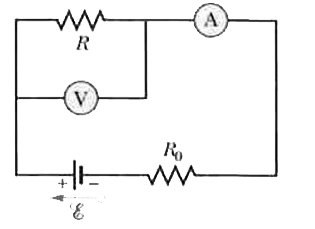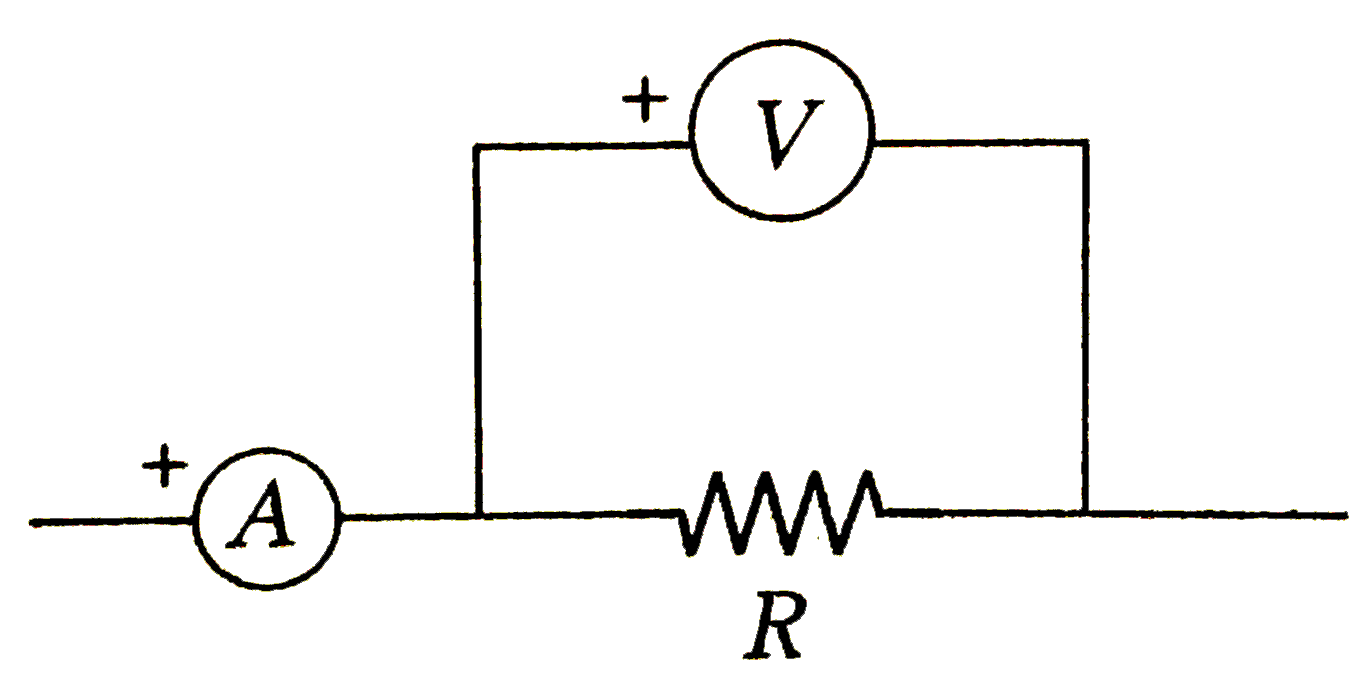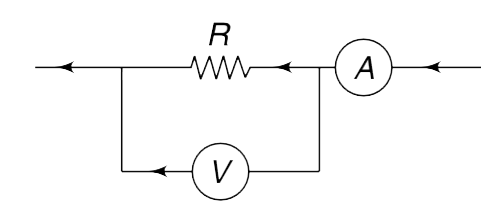In Fig 27-53, a voltmeter of resistance Rv=300Ω and an ammeter of resistance RA=3.00Ω are being used to measure a resistance R in. a circuit that also contains a resistance R0=100Ω and an ideal battery of emf ε=28.5V. Resistance R is given by R=V//i where V is the voltmeter reading and i is the current in resistance R. However, the ammeter reading is not i but rather i', which is i plus the current through the voltmeter. Thus, the ratio of the two meter readings is not R but only an apparent resistance R'=V/I'. If R=85.0Ω what are (a) the ammeter reading. (b) the voltmeter reading, and (c) R' (d) If Rv is increased does the difference between R' and R increase, decrease or on the same?

The correct Answer is:(a) 0.168 A; (b) 11.1 V; (c) 66.2Ω;(d)R'→R as Rv→∞
Topper's Solved these Questions
- CIRCUITSBook:RESNICK AND HALLIDAYChapter:CIRCUITSExercise:Practice Questions (Single Correct Choice Type)
Explore 33 Videos
- CIRCUITSBook:RESNICK AND HALLIDAYChapter:CIRCUITSExercise:Practice Questions (More than One Correct Choice Type)
Explore 12 Videos
- CIRCUITSBook:RESNICK AND HALLIDAYChapter:CIRCUITSExercise:Checkpoints
Explore 7 Videos
- CENTER OF MASS Book:RESNICK AND HALLIDAYChapter:CENTER OF MASS Exercise:Practice Questions (Integer )
Explore 4 Videos
- CIRCULAR MOTIONBook:RESNICK AND HALLIDAYChapter:CIRCULAR MOTIONExercise:CHECK POINTS
Explore 6 Videos
Similar Questions
In Fig. 27-39, a voltmeter of resistance Rv=300Ω and ammeter of resistance RA=3.00Ω are being used to measure a resistance R in a circuit that also contains a resistance R0=100Ω and an ideal battery with an emf of ε=18.0V. Resistance R is given by R =V/i, where V is the potential across R and i is the ammeter reading. The voltmeter reading is V', which is V plus the potential dilference across the ammeter. Thus, the ratio of the two meter readings is not R but only an apparent resistance R' -V/i. If R =85.0Ω what are (a) the ammeter reading.

(b) the voltmeter reading, and (c) R'? (a) If RA is decreased, does the difference between R' and R increase, decrease, or remain the same?
View SolutionA voltmeter of resistance RV and an ammeter of resistance RA are connected in a circuit to measure a resistance R as shown in figure. The ratio of the meter readings gives an apparent resistance R′. Show that R and R′ are related by the relation
1R=1R′−1RV

View Solution
Knowledge Check
An ammeter A, a voltmeter V and a resistance R are connected as shown in the figure. If the voltmeter reading is 1.6V and the ammeter reading is 0.4A, then R is
 Aequal to 4ΩBgreater than 4ΩCless than 4ΩDbetween3Omegaand4Omega
Aequal to 4ΩBgreater than 4ΩCless than 4ΩDbetween3Omegaand4OmegaA 100 V voltmeter of internal resistance 20kΩ n series with a high resistance R is connected to 110 V line. The voltmeter reads 5V, the value of R is -
A210kΩB315kΩC420kΩD4440kΩ
A voltmeter of resistance RV and an ammeter of resistance RA are connected as shown in an attempt to measure the resistance R. The measured value of the resistance is RM=VI0 where V is reading of voltmeter and I0 is reading of the ammeter. find the true value of the resistance in terms of RM,RVandRA.

View SolutionA 100V voltmeter having an internal resistance of 20kΩ is connected in series with a large resistance R across a 110V line. What is the magnitude of resistance R if the voltmeter reads 5V?
View SolutionA battery of emf 3V and internal resistance r is connected in series with a resistor of 55Ω through an ammeter of resistance 1Ω. The ammeter reads 50 mA. Draw the circuit diagram and calculate the value of r.
View SolutionAn ammeter A, a voltmeter V and a resistance R are connected as shown in the figure. If the voltmeter reading is 1.6V and the ammeter reading is 0.4A, then R is

View SolutionA voltmeter of resistance RV and an ammeter of resistance RA are connected in series across a battery of emf E and of negligible internal resistance . When a resistance R is connected in parallel to volmeter , reading of ammeter increases to three times while that of volmeter reduces to one - third. Calculate RAandRV in terms of R.
View SolutionA battery of emf 2 V and internal resistance r is connected in series with a resistor of 10Ω through an ammeter of resistance 2Ω. The ammeter reads 50 mA. Draw the circuit diagram and calculate the value of r.
View Solution

